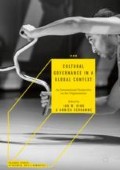Abstract
The objective of this chapter is to review the problems of the arts and culture sector in Ethiopia. A study of various dimensions of culture in the country clearly provides reasons why cultural governance would be beneficial for the prosperity of the sector.
This research involves an in-depth analysis of both primary and secondary data sources. A qualitative survey analysis of respondents was taken as primary data to register the beliefs and values of citizens regarding the status of culture and arts in the country. Later, research studies from development organizations, non-governmental organizations and scholars were analyzed to confirm the verdicts of the respondents.
As part of this research, the author listed the problems of various cultural sectors in different regions of the country. Each problem was studied and collective analysis was provided. The solutions are in line with the five principles of cultural governance, and they are both structural and relevant.
The existing academic literature enumerates problems in the arts and cultural sector and provides suggestions about how to improve the situation. This chapter goes a step further in enforcing the importance of cultural governance for responsible government bodies both locally and nationally. It will benefit further research in this sector, and will help to structure the work of government bodies, stakeholders and people involved in the sector within Ethiopia.
Those piles of ruins which you see in that narrow valley watered by the Nile, are the remains of opulent cities, the pride of the ancient kingdom of Ethiopia. There a people, now forgotten, discovered while others were yet barbarians, the elements of the arts and sciences. A race of men now rejected from society for their sable skin and frizzled hair, founded on the study of the laws of nature, those civil and religious systems which still govern the universe.
Count Volney (Jackson, J. (1939) ‘Ethiopia and the origin of Civilization’, reprinted 2017 by African Tree press, Clifton, NJ.)
Access this chapter
Tax calculation will be finalised at checkout
Purchases are for personal use only
Notes
- 1.
- 2.
- 3.
“Wayback Machine”(PDF). Web. archive.org . 14 February 2012. Archived from the original on 14 February 2012. Retrieved 27 August 2017.
- 4.
- 5.
- 6.
- 7.
- 8.
- 9.
- 10.
- 11.
The state of painting collections at the “national museum of Ethiopia” By Girma Bulti Addis Ababa University School of Graduate Studies, 2016.
- 12.
Stakeholder engagement at the “National Museum Ethiopia” by: Nigussu Mekonnen Abay, Addis Ababa University School Of Graduate Studies April 2016.
References
Abbink, G. J. (2003). A Bibliography on Christianity in Ethiopia (ASC Working Paper).
Barber, T., & Krivoshlykova, M. (2006). Global Market Assessment for Handicrafts. United States Agency for International Development.
Biasio, E. (1993). Contemporary Ethiopian Paintings in Traditional Style: ‘Traditional’, ‘Folk’, or ‘Popular’ Art? In Third International Conference on the History of Ethiopian Art, Addis Ababa.
Biasio, E. (2009). Contemporary Ethiopian Painting in Traditional Style Beginning and Change. In S. Ege, H. Aspen, B. Teferra, & S. Bekele (Eds.), Proceedings of the 16th International Conference of Ethiopian Studies. Trondheim: Norwegian University of Science and Technology, Norway.
Contreras, P., Carlos, J., Vásquez, G. G., & Tapias, G. B. (2009). Challenges Faced by Rural Communities of Artisans: An Eco-Technological Proposal for Sustainable Handcrafting. Acta Agronómica, 58(3), 206–220.
Curran, J., & Blackburn, R. (2000). Researching the Small Enterprise. London: Sage.
Dagne, H. G. (1984). The Scriptorium at the Imperial Palace and the Manuscripts of Addis Ababa Churches. In Proceedings of the Eighth International Conference of Ethiopian Studies (pp. 215–223). Addis Ababa: University of Addis Ababa.
Dubois, J. (2008). Roots and Flowerings of Ethiopia’s Traditional Crafts. Addis Ababa: UNESCO.
Erlikh, H. (2013). Islam, Christianity, Judaism and Ethiopia: The Messages of Religions. Nehemia Levtzion Center for Islamic Studies, Institute of Asian and African Studies, Hebrew University of Jerusalem.
Eshete, A. (1982). The Cultural Situation in Socialist Ethiopia. Paris: UNESCO.
Fillis, I. (2007). An Examination of Celtic Craft and the Creative Consciousness as a Contribution to Marketing Creativity. Journal of Strategic Marketing, 15(1), 7–16.
Karbo, T. (2013). Religion and Social Cohesion in Ethiopia. International Journal of Peace and Development Studies, 4(3), 43–52.
Kumar Jena, P. (2010). Indian Handicrafts in Globalization Times: An Analysis of Global-Local Dynamics. Interdisciplinary Description of Complex Systems, 8(2), 119–137.
Lanjouw, P., & Feder, G. (2001). Rural Non-Farm Activities and Rural Development: From Experience Towards Strategy. Washington, DC: World Bank Rural Development Family.
Mocria, E., Messele, M., & Hiwot, A. G. (2003). Survey of Culture and Media: Ethiopia. SIDA: Stockholm, Sweden.
Moon, M. J. (2001). Cultural Governance: A Comparative Study of Three Cultural Districts. Administration & Society, 33(4), 432–454.
OECD. (2010). SMEs, Entrepreneurship, and Innovation. Paris: OECD. http://www.oecd.org/cfe/smesentrepreneurshipandinnovation.htm.
Pankhurst, R. (1966). Some Notes for a History of Ethiopian Secular Art. Ethiopia Observer, 10(1), 5–80.
Schramme, A., Schrauwen, J., & Rommes, C. (2012). Goed bestuur voor cultuur: over‘corporate governance’in de cultuursector.
Sirika, B. (2008). Socio-economic Status of Handicraft Women among Macca Oromo of West Wallaga, Southwest Ethiopia. Ethiopian Journal of Education and Sciences, 4(1), 1–14.
Stanisław, C. (1999). Ethiopian Religious Art-its Significance And Forms of Expression. Warszawskie Studia Teologiczne, XII/2/1999, 47–49.
Tarsitani, B. A. (2009). Merging Past and Present in the Museums of Harar, Ethiopia. Nilo-Ethiopian Studies, 13, 1–16.
Tetteh, E., & Burn, J. (2001). Global Strategies for SME-Business: Applying the SMALL Framework. Logistics Information Management, 14(1/2), 171–180.
Van der Pol, H. (2007). Key Role of Cultural and Creative Industries in the Economy. UNESCO Institute for Statistics. Canada. OECD [online].[cit. 2014-03-21]. Dostupné z: http://www.oecd.org/site/worldforum06/38703999.pdf.
Author information
Authors and Affiliations
Editor information
Editors and Affiliations
Rights and permissions
Copyright information
© 2019 The Author(s)
About this chapter
Cite this chapter
Khurana, K. (2019). Ethiopia. In: King, I., Schramme, A. (eds) Cultural Governance in a Global Context. Palgrave Studies in Business, Arts and Humanities. Palgrave Macmillan, Cham. https://doi.org/10.1007/978-3-319-98860-3_2
Download citation
DOI: https://doi.org/10.1007/978-3-319-98860-3_2
Published:
Publisher Name: Palgrave Macmillan, Cham
Print ISBN: 978-3-319-98859-7
Online ISBN: 978-3-319-98860-3
eBook Packages: Business and ManagementBusiness and Management (R0)

